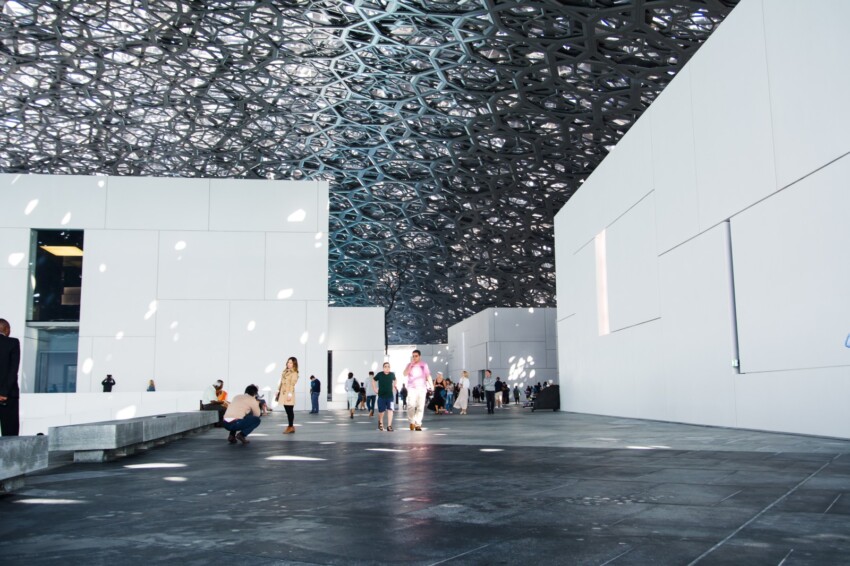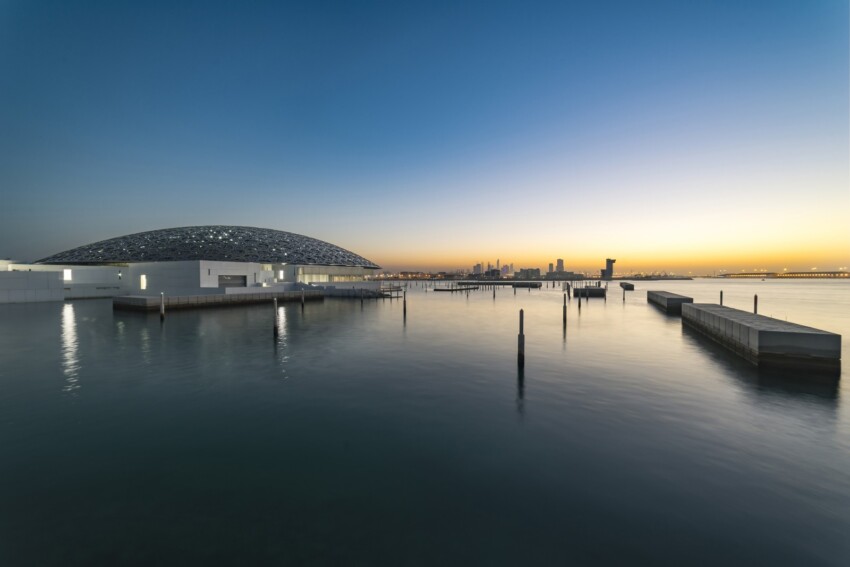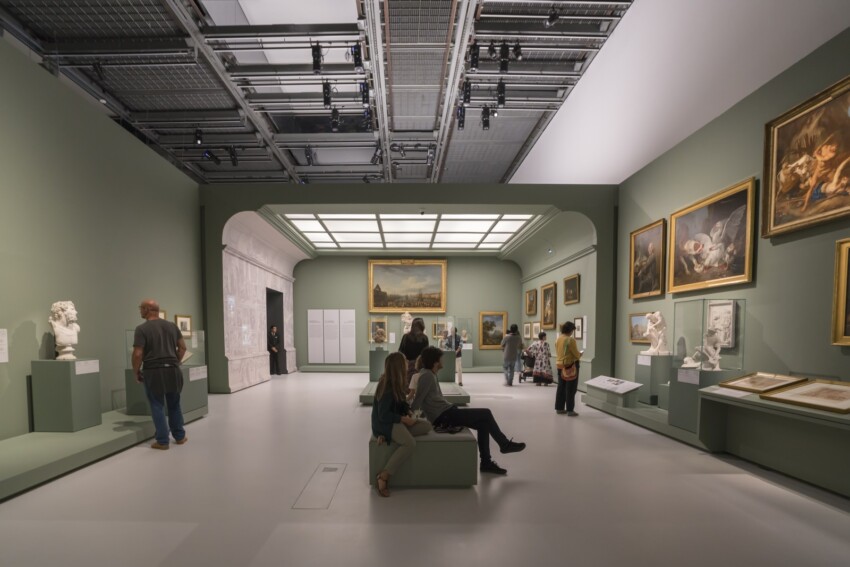
Where is the Louvre Museum? Until a few years ago, this question would have sounded ridiculous, but now the Louvre is no longer just a museum in Paris: the wealthy city of Abu Dhabi in the United Arab Emirates has in fact equipped itself with a huge exhibition venue whose name is inspired by the famous French institution.
More than a tribute to the world’s most visited museum, the Louvre in Abu Dhabi is a challenge: as part of an ambitious project involving the construction of other important cultural institutions, its declared aim is to make the capital of the United Arab Emirates a leading city on the world cultural scene.
The realisation of the museum was only possible thanks to an agreement between the Abu Dhabi city administration and France, which allows the Arab museum to use the name ‘Louvre’ for 30 years and 6 months, to benefit from loans of works and specialised museum personnel, and to have four exhibitions per year for 15 years organised by French museums.
How much money France has pocketed for this colossal cultural marketing operation is top secret. What is certain is that it is a stratospheric sum, to which must be added the billions spent on the construction of the work.
In pure UAE style, the Louvre in Abu Dhabi is a colossal work in terms of cost and size, which will not fail to astound you with its magnificence and ultra-modern functionality. The museum’s artistic mission is on an equal level: it traces the history of world creativity with hundreds of paintings, sculptures, installations, ceramics, manuscripts and other works from all over the world.
Although it is a controversial work at the centre of much controversy – first and foremost, the exploitation of the 5,000 workers who worked on its construction in conditions bordering on slavery – it is really hard to resist its appeal.
Take advantage of a holiday in Abu Dhabi or nearby Dubai to visit the new Louvre: it may have less history and fewer works than the Parisian one, but it is a must-see attraction.
The Louvre Abu Dhabi, a monumental work in itself, is only the first piece of a larger project that aims to build a new identity for the city and to make Abu Dhabi a cultural destination of equal importance to other more emblazoned ones.
The economic investment for the realisation of the project is considerable, but the return will surely be proportionate… or probably much greater.

The headquarters of the Louvre Abu Dhabi is a masterpiece of contemporary architecture: it is worth the money for the ticket alone. From a distance it looks like a refined concrete pile dwelling on the sea; inside it is a luminous labyrinth of white galleries displaying magnificent artistic creations in the most diverse styles.
The project is by Jean Nouvel, internationally renowned architect and winner of prestigious awards – including the Golden Lion at the Venice Biennale – and author of iconic works such as the Agbar tower in Barcelona, the Copenhagen Concert Hall and the extension of the Queen Sofia Museum in Madrid.
The French archistar openly wanted to integrate his work into the landscape, a difficult operation considering that the island on which the new Louvre stands was completely deserted at the time of its construction. To do this, he decided to go against the custom of the Emirates, that is, to develop buildings in height, and designed a museum composed of low buildings arranged in an (apparently) haphazard manner to give visitors the idea of moving inside a medina.
The scorching temperatures in Abu Dhabi posed a big challenge: how to make a visit enjoyable in extreme weather conditions? Two stratagems were used to make the Louvre Abu Dhabi hospitable and usable: building it on the sea and equipping it with a mega-dome to shelter the buildings from the scorching sun. The result is a cool micro-climate that makes it possible to walk outside the buildings without suffering.
The hallmark of the Louvre Abu Dhabi is its huge dome, built to give the impression of floating on water and entirely perforated to create a striking rain of light effect.
The Louvre Abu Dhabi is the first major work built on Saadiyat Island, north of the city centre. Until 10 years ago this area was completely deserted, today the view is an uninterrupted line of cranes at work: the island is in fact destined to become a district entirely dedicated to art and culture and is already indicated on road signs as ‘Cultural District’.
Next to the Louvre Abu Dhabi will rise other pharaonic works designed by the most important international contemporary architects:
There are also plans to build a university campus, dozens of hotels, three harbours, 8000 villas and 38,000 residential units on the island.

A visit to the Louvre Abu Dhabi is an excursion into the world history of creativity. As no other museum has ever done before, the Louvre Abu Dhabi aims to make evident the connections between artistic creations created in different parts of the world. From this survey emerges a common fabric of ideas and values, beyond cultural and religious differences, that define the concept of humanity.
In order to put East and West on an equal footing, the exhibition at the Louvre Abu Dhabi follows a chronological order rather than dividing the works by geographical areas. It is divided into four macro-areas: Ancient Age, Middle Ages, Modern Age, Globalisation.
Among the museum’s highlights are the following works:
In addition to the permanent exhibition, it is possible to see temporary exhibitions organised in collaboration with prestigious French museums.
You can buy your ticket online and save the queues at the ticket counters; there are discounted tickets for 13 to 22 year olds while children under 13 get in free. The ticket allows entry to the museum galleries, temporary exhibitions, the children’s museum and the outdoor areas under the dome.
Inside the museum there are two cafés, a haute cuisine restaurant, a gift shop and a bookshop.
The Louvre Abu Dhabi is an attraction not to be missed, even if you are short of time and are staying in Dubai. Many tourists take part in a convenient daily guided tour departing from and returning to Dubai, combining a visit to the museum with one to the Sheikh Zayed Mosque.
The Louvre Museum Abu Dhabi is open 6 days a week (closing day: Monday), from morning until evening. It is open extended hours on Thursdays and Fridays.

The Louvre Abu Dhabi is easily accessible from the city centre either by car or public transport. You can take the local bus No. 94 and get off at the Saadiyat Island stop, a short walk from the museum entrance. There is a taxi rank in front of the main entrance to the visitors’ car park.
To get to the Louvre Abu Dhabi from Dubai calculate about one and a half hours by car. Take the E11 southbound and exit at Saadiyat Island/Yas Island to join the Sheikh Khalifa Highway E12. Continue to the Cultural District/Louvre Abu Dhabi exit and follow the signs to the museum.
The Louvre Abu Dhabi is located onSaadiyat Island, about 25 km from the centre of Abu Dhabi and 11 km from the famous Corniche Beach. Dubai is 140 km away to the north.